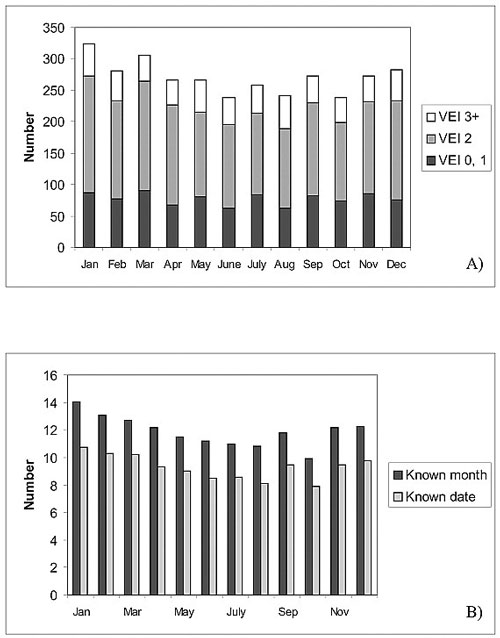From ye olde blog: in August last year, the BBC website published a rather silly story story discussing the possibility that an imminent full moon would trigger an eruption of Mount Mayon in the Phillipines. It didn’t, and Phil Plait at Bad Astronomy was suitably mocking about the rather poor science behind this claim, but I felt a bit more could be added from a geological perspective: are there external factors which can predictably influence when a volcano erupts?
We need to be careful about what this story is and isn’t about. What it’s not about is the notion that a completely inactive volcano is suddenly going to be woken up; it’s more about the potential of tidal forces to act as a trigger for a volcano which is already predisposed to erupt (e.g. has a full magma chamber under pressure). As the earth rotates beneath the Moon, its gravity not only pulls on the water directly beneath it, but also stretches the underlying crust. The effect is small, but it could be enough to destabilise a finely balanced system and cause an eruption.
If this is the case, we’d expect a statistical correlation between the strength of tidal forces and the frequency of volcanic eruptions, with eruptions more likely when those forces are strongest. These variations could potentially be associated with both the twice daily (diurnal) high tide-low tide cycles, and also the monthly spring-neap cycles, which is what the BBC article is referring to: spring tides occur at full and new moons (for completeness, I should point out that this latter cycle is a result of the changing relative position of the sun with respect to the moon; see here).
As Phil points out, for Mount Mayon there is no apparent correlation:
…the BBC report says that the full Moon “coincided with at least three of Mayon’s 47 eruptions, including the two most recent ones in 2000 and 2001”.
…Let’s be generous and say that the time period around the full Moon is 2 days: a day before and a day after. The Moon goes through a complete cycle in roughly 29 days, so it’s full for 2/29 = 1/15th of the time. If you then look at 47 eruptions, then [if tidal forces have no effect] you expect to see 47/15 = 3 eruptions near the full Moon. And hey, that’s exactly what the report says!
In the comments someone posted a link to this article which discusses possible evidence for a link elsewhere, particularly in the eruptive pattern of Stromboli. It’s a puff piece for a documentary though, so there’s no hard data (and I can’t find any publications about it). Besides, if we want to rigorously prove a link, we don’t want to look at the eruptive history of individual volcanoes; we want to look at the global eruption record. This was done in a paper published by Mason et al. in the Journal of Geophysical Research in 2004 [doi]. Their analysis:
We found no conclusive evidence for a general correlation between volcanic activity and lunar tidal phase. This result is consistent with recent work which indicates that diurnal and fortnightly tidal stresses may be too short-lived and strain rates too high to effect a significant viscous response in partially molten regions of the Earth’s subsurface.
In other words, it appears the pressure changes induced by tidal forces are not a significant factor in triggering an eruption. However, the authors in this paper did notice a seasonal variation in global eruption rates. Their Figure 1, shown below indicates that slightly more eruptions start between November and April, compared to the period between April and October. The top subfigure is subdivided according to the eruption size according to the Volcanic Explosivity Index.

This variation appears small but is statistically significant; less clear is the mechanism which drives it. The authors suggest seasonal changes in crustal loading due to variations in sea level, atmospheric pressure, ice and snow cover, and other effects of the hydrological cycle.
Seasonality in eruptions is correlated with environmental fluctuations associated with the deformation of the Earth in response to the annual hydrological cycle, including falls in sea level, millimeter-scale motion of the Earth’s crust, and falls in regional atmospheric pressure.
This would fit in with recent speculations about the effect of melting ice sheets and glaciers on volcanic activity (pronouncements of impending doom notwithstanding).
So it seems that external sources may be able to influence the timing of volcanic eruptions; it’s just that the Moon is not one of them. But how about the other obvious potential influence: the effect of a large nearby earthquake? Tune in tomorrow to find out… guest starring a true geological pioneer, even if he has been co-opted by biologists.



Comments (6)